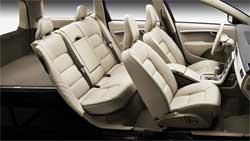Volvo designs special cabins for the allergy prone
28 August 2008
The German luxury car maker Volvo's S80, V70 and XC70 models have been approved by the Swedish Asthma and Allergy Association for those suffering from allergies, as the cabins have been designed to provide a safe interior environment for them.
To ensure the quality of the air in passenger car compartments, Volvo decided to establish specifications and institute testing for car interiors in the mid-1990s. The purpose was to create an environment inside the car that was also safe for those known to hypersensitive allergics. In 1998, Volvo S80 was the first model in which this work was incorporated.
 Up to 45 per cent of the population in the industrialy advanced nations are estimated to suffer from some form of allergy, of which over 10 per cent have asthma.
Up to 45 per cent of the population in the industrialy advanced nations are estimated to suffer from some form of allergy, of which over 10 per cent have asthma.
One of the reasons for the dramatic increase in such ailments since the 1950s can be attributed to the rise in air pollutants such as nitrogen oxides, ground-level ozone, particulates and pollen.
One of Volvo's objectives in designing vehicles with cabins for the hyper-alletrgics was to ensure that the air quality inside the cabin was cleaner than the air outside.
What is often referred to as the "new car smell" is actually low levels of emissions from materials such as PVC plastics and certain metals. These emission levels are so low that they do not present any health hazard, but when the car becomes warm, the emissions concentrations may increase, aggravating the hypersensitive. Though these substances are quickly vented out of the cabin, Volvo aimed at providing a completely odour-free environment.
The automaker says that work on the interior environment can be divided into two main areas - air quality and contact allergies. To ensure that the air entering the cabin is as clean as possible, Volvo has developed two systems: IAQS (interior air quality system ) and CZIP (clean zone interior package).
